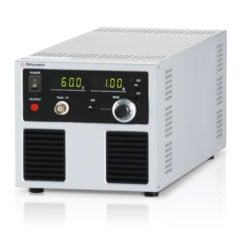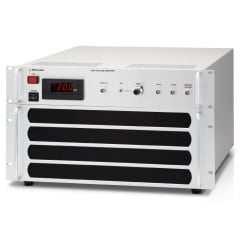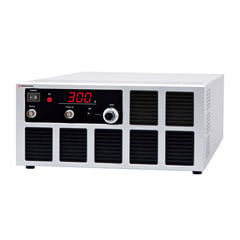Type and Characteristics of Amplifier
If you search for "amplifier" on the Internet, you will get results from many websites about audio power amplifiers. But the "amplifier" itself is not just for audio. The device that amplifies something is called an amplifier. Of course, in the electrical circuit, including the audio power amplifier, the various signals are exchanged as electrical signals. In electronics, an amplifier is a device that boosts an electrical signal, increasing either its input current or voltage. It operates by amplifying the electric signal output from the various sensors and making it easy to perform the analog-to-digital conversion.

Amplifiers are a cornerstone of analog circuits; in fact, they are so fundamental that analog electronics would be virtually nonexistent without them. In addition, since the amplifier can supply any electric current and voltage (or electric power), it can also be used as a power supply simulator. In fact, the power supply is also a kind of amplifier. DC power supplies are also called unipolar (power supply) because of being able to supply positive charge only.
We call a two-quadrant bipolar power supply that can supply current sources of a positive and negative charge, and a four-quadrant bipolar power supply that can also supply a current sink. We will introduce the four-quadrant bipolar power supply in detail in the last chapter.
There are two main types of amplifiers called "linear amplifier" and "digital amplifier".
A "linear amplifier" has a frequency domain where the output signal is linearly amplified with respect to the input signal and a domain where it is nonlinear due to the characteristics of the amplifying elements such as transistors and FETs that make up the electric circuit. In particular, the output signal becomes non-linear in the region near zero, and the ON/OFF operation of the input signal to the element causes distortion in the output waveform. Therefore, it becomes important in which region the input signal is used, and it falls into three categories, Class-A, Class-B, and Class-AB (including Class-AB1 and Class-AB2).
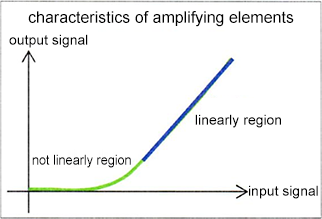
Class-A amplifiers
This amplifier uses only the linearly amplified region of the element. Therefore, although the linearity is high, it is necessary to supply a bias current (or voltage) even when the input signal is close to zero, which is disadvantageous in that the efficiency is degraded and the heat generation is large. That is, to ensure that the output signal is correct, it always keeps a constant bias current even when the input signal is zero.
Class-B amplifiers
This amplifier uses both the non-linearly and the linearly amplified region of the element as it is. Therefore, when the input signal is near zero, the output signal is also zero and distortion occurs. Instead, there is no need for bias current like Class-A amplifiers, and the efficiency is improved.
Class-AB amplifiers
It is an amplifier that has a good reputation between Class-A and Class-B. Distortion is canceled by adding a bias current to a Class-B amplifier.
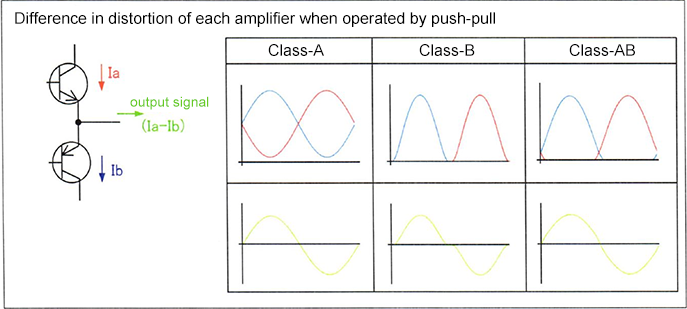
Another amplifier is a "digital amplifier," also called a switching amplifier, class-D amplifier. This is more efficient and smaller than linear amplifiers by using switching techniques such as PWM. It is mainly used for compact audio power amplifiers such as automotive applications. Although MOSFETs and IGBTs are used as switching devices, there is also the problem that the frequency band of the corresponding input signal is narrow.

Conditions Necessary for Stable Operation of the Amplifier
So far, we have explained the type and characteristics of the amplifier. From here, we will introduce what kind of things we should be careful about when designing and implementing an amplifier.
Frequency band
In order to electric current and voltage output values to stabilize, it is necessary to understand the factors that inhibit them. The first factor is the frequency band. The frequency band corresponds to the operating speed of the amplifier. At high frequencies, the amplifier cannot keep up with the input signal and the amplitude of the signal decreases. The figure shows the frequency until the amplitude reaches -3 dB in the frequency band.
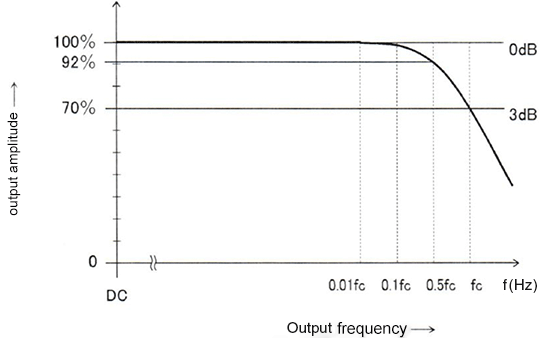
For example, when the frequency band of a 120 V rated amplifier is 20 kHz, even if it tries to output a ± 20 V sine wave at 20 kHz, the output amplitude becomes 70% at -3 dB, so it becomes a ± 14 V sine wave. Therefore, it is necessary to select an amplifier with a frequency band with a margin for the frequency you want to use. The rise time and fall time are related to the frequency band. Generally, the rise time of the response speed (= frequency band) fc (Hz) amplifier can be obtained by tr ≑ 0.35/fc.
Slew rate
The second factor is a slew rate that represents the response speed of the amplifier. This shows the maximum voltage rise rate of the amplifier. Generally, it is expressed by the amount of voltage change per microsecond. The response speed of the amplifier may be limited by the frequency band or by this slew rate. When the step response is limited by the slew rate, the rising waveform becomes straight, as shown in the figure.

the case limited by slew rate

the case limited by frequency band
Inductive load (e.g., coils, electromagnets, and motors)
So far, it was due to speed, but now we will introduce things related to load. The first factor is an inductive load.
For an inductive load, where the voltage-current relationship is defined as
(with L being the inductance), operating at high speed under constant-current (CC) control can generate a significant counter-electromotive force, which may pose a challenge.
This is a critical consideration in applications such as the high-speed driving of magnetic coils or testing automotive solenoids.
For example, when trying to output a square wave with a fast rise speed, the desired waveform may not be obtained because the voltage is limited by the overvoltage protection. In such a case, it is necessary to slow the rising speed of the input signal and select a model that supports the generated voltage.

In addition, using a step-like signal such as digital control for the input signal will generate many voltage pulses as well. As these pulses may create a problem, it is recommended to use continuous waveform input signals as much as possible.
On the other hand, overvoltage protection also limits the output signal. However, if the output signal is suddenly turned off, the protection does not work and a large voltage may be generated from the inductive load.
Capacitive load (e.g., capacitors, piezoelectric actuators, and MEMS devices)
The second factor is the capacitive load. For a capacitor, the relationship is governed by the equation , where C is the capacitance. Contrary to inductive load, a large current is required when trying to operate at high speed under constant-voltage (CV) control. When handling a high capacity, understand the load characteristics and the output characteristics of the power supply before use.
When driving piezoelectric elements for precise positioning, a large peak current is required for rapid voltage changes.
Diode load
The third factor is a diode load. Under constant-current (CC) control, even if the current control is zero under no load condition, the output voltage rises to the positive or negative overvoltage protection level under the influence of a slight offset. This means that a diode or other load that only allows forward current can output signal an excessive voltage in the reverse direction even when the current control is zero. If this exceeds the withstand voltage of the load, it may cause a failure, so it is necessary to take measures such as inserting a protective diode in the reverse direction.
Capacitance and inductance of cable
Last factor is the cable. When operating the amplifier at high speed, we cannot ignore the effects of the capacitance and inductance of the cable for the output signal. In high-voltage amplifiers, the cable has a capacitance between the output wire and the shield, so the capacitance affects the rising speed of the voltage waveform. The longer cable has a greater capacity. This is the reason for using a low electrical resistance cable among music enthusiasts and building a system that minimizes the length of the cable.
In addition, in the low-voltage, high-current model, the inductance of the cable and the inductance generated by the wiring method greatly affect the rise speed of the current waveform. This can be mitigated to some extent by making the current loop smaller, such as twisting the wiring.
Four-quadrant Bipolar Power Supply
Finally, let us introduce the four-quadrant bipolar power supply, which is a high-performance amplifier, as an evolution of the amplifier. The amplifier basically has an output current sink. As a result, the constant-voltage operation is possible even with capacitive loads, inductive loads, and their combined loads. Furthermore, its fast response time makes it an ideal power supply for many demanding applications. A general power supply can only output electric current in one direction. But a four-quadrant bipolar power supply can output voltage in both positive and negative directions.
Moreover, it has a current sink and source function. When applying an alternating current to an inductive load or capacitive load, the same voltage may have positive and negative currents. A four-quadrant bipolar power supply is required to drive such a load.


Under constant-voltage (CV) control, a four-quadrant bipolar power supply output voltage corresponds to the input signal. At this time, the output current can take value freely if it is within the rating. Similarly, under constant-current (CC) control, it outputs current according to the input signal. At this time, if the output voltage is within the rating, it can be a positive or negative free value.
However, because the output protection is performed by the overvoltage protection and the overcurrent protection, the desired waveform may not be obtained. It is desirable to operate so that both voltage and current are within the rating, and it is important for stable use of the power supply to understand the characteristics of the load.
Related Technical Articles
Recommended products
Matsusada Precision's high-performance Amplifier and Bipolar power supplies
Reference (Japanese site)
- Japanese source page 「アンプの利用と、その注意点」
(https://www.matsusada.co.jp/column/column-amp.html) - D級アンプ:基本動作と開発動向
https://www.maximintegrated.com/jp/app-notes/index.mvp/id/3977 - 周波数特性とは(電子回路設計 入門サイト)
(https://www.kairo-nyumon.com/analog_frequency.html)



